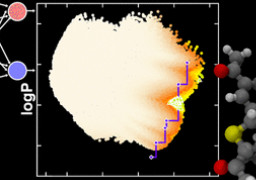




 |
 |
 |
|||
 |
 |
 |
 |
 | |
 |
 |
 | |


| 미디어 브리핑스 | 내서재담기 |


  |
 |  |
*****
양자 얽힘 광자를 통한 더 안전한 위성 기반 통신 암호화 방식 개발
한 국제 연구팀이 이전에는 접근할 수 없었던 스펙트럼 범위에서 양자 얽힘(quantum-entangled) 광자를 생성하는 새로운 방법을 개발하여 앞으로 위성 기반 통신의 암호화를 훨씬 더 안전하게 만들었다.
영국, 독일, 일본의 15명으로 구성된 이 연구팀은 2.1 마이크로미터의 파장에서 양자 얽힘 광자를 생성하고 검출하는 새로운 방법을 개발했다. 실제로, 얽힘 광자는 양자 키 분배(quantum key distribution)와 같은 암호화 방식에 사용되어, 두 당사자 간의 통신을 도청 시도로부터 완전히 보호한다. 이번 연구 결과는 최근 「사이언스 어드밴스(Science Advances)」에서 사상 처음으로 대중에게 발표되었다.
지금까지는 700~1550 나노미터의 근적외선 범위에서만 이러한 암호화 메커니즘을 구현할 수 있었다. 이렇게 짧은 파장은 대기의 광 흡수 가스와 태양의 배경복사에 의해 방해받기 때문에 특히 위성 기반 통신에서 단점을 보인다. 기존 기술로서는, 전송되는 데이터의 종단(end-to-end)간 암호화는 ‘야간에만’ 보장될 수 있다.
2 마이크로미터 파장의 얽힘 광자 쌍(pairs)은 태양 배경복사의 영향을 상당히 덜 받는다. 또한 소위 ‘투과 창(transmission window)’은 지구 대기에 2 마이크로미터의 파장에 존재한다. 이것은 이러한 광자가 대기 가스에 덜 흡수되어 보다 효과적인 통신이 가능하다는 의미이다.
실험을 위해 이들 연구원들은 니오브산리튬(lithium niobate)으로 만든 비선형 크리스탈을 사용했다. 이들이 레이저로 크리스탈에 초단광 펄스(untrashort light pulse)를 보낼 때, 비선형 상호작용이 2.1 마이크로미터의 새로운 파장을 가진 얽힘 광자 쌍을 생성했다.
이제 다음으로 중요한 단계는 이 시스템을 광 통합 장치로 변환, 이 시스템을 소형화하여 대량생산에 적합하게 만들어 다양한 응용 방식으로 활용하는 것이다.
- Science Advances, March 27, 2020, “Two-Photon Quantum Interference and Entanglement at 2.1 μm,” by Shashi Prabhakar et al. ⓒ 2020 American Association for the Advancement of Science. All rights reserved.
To view or purchase this article, please visit
https://advances.sciencemag.org/content/6/13/eaay5195
*****
NK 백혈구의 파킨슨 병 억제에 대한 새로운 연구
조지아 대학의 재생 생명과학 센터(Regenerative Bioscience Center)의 연구자들이 ‘NK(자연살해, natural killer)’ 백혈구가 파킨슨병으로 이어지는 연쇄적인 세포 변화를 막아, 이 질병의 진행을 멈추게 할 수 있음을 발견했다.
NK 세포는 종양을 죽일 수 있는 백혈구로, 박테리아나 바이러스가 침입하면 첫 번째 방어선을 구축한다. 이들에게는 세포 스트레스를 감지하고 감염으로 인해 변이된 세포를 식별할 수 있는 활성 수용체가 장착되어 있다.
현재 파킨슨병의 진행에 변화를 주거나 멈추게 하는 치료법은 없다. 최근 미 국립과학원(National Academy of Sciences) 논문집에 실린 이 연구는 실제로 이 병을 막을 가능성을 보여주는 최초의 연구라 할 수 있다.
이는 NK 세포가 파킨슨 병 및 기타 신경 퇴행성 장애의 특징인 뇌 조직의 염증과 단백질 응괴를 조절하고 억제하는데 매우 중요할 수 있음을 보여준다. 이 연구는 실험용 쥐 모델에서 NK 세포 고갈이 질병 상태를 더 크게 악화시키는 것 또한 발견했다. 이것은 NK 세포가 없으면 신경계가 공격에 취약해진다는 점을 밝힌 것이다.
우리는 NK 세포가 뇌의 염증을 감소시키고 독성 물질을 생성하는 단백질을 제거하는 능력으로 보호력을 발휘한다고 믿는다. NK 세포가 없는 경우, 단백질이 확인되지 않은 채 남게 되고, 연구자들은 바이러스 저항 세포의 실질적 감소를 보았고, NK 세포가 면역계 반응을 촉진시키는 신호 전달 단백질의 중요한 원천임을 최종 확인하였다.
연구자들은 파킨슨 병에 대한 이러한 연구가 동물 모델에서 제한적으로 이루어졌지만, 앞으로의 면역 요법 개발에 긍정적이다. 이들은 신경 교종으로 불리는 공격적 형태의 뇌암에 대한 면역 요법을 테스트한 최근 인간 시험을 인용했는데, 이는 NK 세포가 종양 세포의 제거에 기여하고 면역계 방어를 지원하는 메시지를 방출한다는 것을 나타내는 것이다.
예비 데이터는 NK 세포의 수와 기능이 노령 동물에서 감소되어 정상적인 기능을 수행하는 능력이 손상되었음을 보여준다. 연구원자들은 NK 세포 생물학과 관련된 연령 관련 변화와 노인들의 건강과 복지에 대한 더 폭넓은 의미를 더 깊게 들여다보고자 한다.
- Proceedings of the National Academy of Sciences, NK Cells clear A-Synuclein and the Depletion of NK Cells Exacerbates Synuclein Pathology in a Mouse Model of α-Synucleinopathy,” by Rachael H. Earls, et al. ⓒ 2020 National Academy of Sciences. All rights reserved.
To view or purchase this article, please visit:
https://www.pnas.org/content/117/3/1762
*****
기계 학습 신경 네트워크를 통한 물질의 새로운 발견
배터리나 다른 에너지 관련 장치와 같은 특정 응용 분야에 대한 현재 가능성 있는 새로운 물질들에 대한 이론상 목록을 검색할 때, 고려될 수 있는 잠재적 물질만 수백만 가지에 이르고 충족되고 최적화되는데 필요로 하는 다중 기준이 있다.
최근 MIT 연구자들은 기계 학습 시스템을 활용하여 이러한 발견 과정을 획기적으로 간소화할 수 있는 방법을 찾아냈다. 이 발견은 재료화학 국제저명학술지인 「ACS 센트럴 사이언스(ACS Central Science)」 저널에 최근 게재되었다.
이에 대한 증명으로, 이 연구팀은 플로우 배터리(flow battery)로 불리는 에너지 저장 시스템을 위한 거의 3백만 개의 후보 물질로부터 가장 유망한 8가지 물질 세트를 식별해냈다. 이 과정은 기존 분석 방법으로는 50년이 걸리지만, 이들은 단 5주 만에 이 일을 해냈다.
이 연구는 전이 금속 복합체(transition metal complexs)로 불리는 일련의 물질들을 조사했는데, 이들은 매우 광범위하게 다양한 형태로 존재할 수 있다. 이 물질들이 왜 그렇게 작용하는지 이해하는 유일한 방법은 양자 역학을 사용하여 연구하는 것이다.
현실적으로, 수백만 가지 물질 각각의 특성을 예측하려면 많은 시간과 자원 집약적인 분광법 또는 각각의 가능성 있는 후보 물질들이나 물질들의 조합에 대한 느리고 매우 복잡한 물리학 기반의 컴퓨터 모델링을 필요로 한다. 각 연구마다 수일의 시간이 소요될 것이다.
MIT 연구팀은 이 대신 가능한 적은 수의 다른 물질들을 활용했다. 이들은 이 물질을 활용하여 각 물질들의 화학적 구성과 그들의 물리적 특성 간의 관계에 대해 보다 개선된 기계 학습 신경 네트워크를 학습시켰다. 이후 그러한 지식은 신경 네트워크의 다음 학습에 사용되어지도록 가능성 있는 새로운 차세대 물질에 대한 제안을 형성하는 데 적용되었다. 이러한 과정을 연속적으로 4번 거침으로써, 신경 네트워크는 매번 크게 개선되었고, 더 이상 개선되지 않을 것이 분명한 지점에 도달했다.
이러한 반복을 통한 최적화 시스템은 연구가 추구하는 두 가지 상충되는 기준을 만족시키는, 잠재적 솔루션에 도달하는 프로세스를 상당히 간소화시켰다. 하나의 요소를 개선하면 다른 요소가 악화되는 경향이 있는 상황에서 최상의 솔루션을 찾는 이러한 종류의 프로세스는 파레토 프론티어 (Pareto frontier)로 알려져 있고, 한 요소를 더 개선하면 다른 요소를 악화시킬 수 있는 지점에 관한 그래프를 보여준다. 즉, 이 그래프는 각각의 요소에 할당된 상대적 중요도에 따라 가능한 최상의 절충점을 나타내준다.
일반적인 신경 네트워크를 학습시키는 데는 수천에서 수백만의 사례에 이르는 매우 거대한 데이터 세트가 필요하다. 그러나 MIT 팀은 파레토 프론티어 모델을 기반으로 이 반복 프로세스를 사용하여 프로세스를 간소화하고 수백 가지 샘플만을 사용하여 신뢰할 수 있는 결과를 도출할 수 있었다.
플로우 배터리 물질을 찾는 사례에서, 연구가 종종 그렇듯 원하는 특성들이 상충되었다. 즉 최적의 물질은 높은 용해도와 에너지 밀도를 지니는데, 이 밀도는 주어진 무게로 에너지를 저장하는 능력이다. 그러나 용해도를 높이면 에너지 밀도가 감소하는 경향이 있으며 그 반대도 마찬가지이다.
이에 신경 네트워크는 유망한 후보 물질들을 신속하게 도출할 수 있었을 뿐만 아니라, 각 반복을 통해 다른 예측에 대한 신뢰 수준을 할당할 수 있었으며, 이는 각 단계에서 샘플 선택을 구체화하는 데 도움을 주었다. 연구팀은 이러한 모델이 언제 실패할 것인지를 실제로 파악할 수 있는 동급 최고의 ‘불확실성 정량화 기술’을 개발했다.
이 시스템을 사용하여 추가 조사를 위해 제안된 특정 ‘전이 금속 복합체’ 외에도 이 방법은 그 자체로 훨씬 더 광범위하게 응용될 수 있다. 이 방법을 여러 목표들을 한 번에 해결하려는 모든 물질 설계 과제에 적용 가능한 프레임 워크로 생각해보라. 오늘날 가장 흥미로운 물질 디자인 과제 모두는 한 번에 하나씩 진행되고 이는 개선을 시도하고 있지만 하나의 개선이 다른 것을 악화시키는 문제가 있다. 산화 환원 플로우 배터리는 연구자들이 기계 학습과 물질 발견을 가속화할 수 있는 좋은 사례의 하나에 불과하다.
일례로, 다양한 화학 산업 프로세스를 위한 촉매 최적화는 또 다른 종류의 정교한 물질 검색 작업이라 할 수 있다. 현재 사용되는 촉매는 종종 희귀하고 값 비싼 원소를 포함하므로 풍부하고 저렴한 재료를 기반으로 유사한 효과적인 화합물을 찾는 것은 큰 이점을 가져다줄 것이다.
이번 MIT 팀의 연구는 화학에서 다차원의 개선을 이뤄낼 수 있는 첫 번째 응용일 것이다. 그러나 이 연구의 장기적 의미는 방법론 그 자체에 있다. 다른 방법으로는 달성하기 어렵기 때문이다. MIT 팀 연구원들은 이렇게 설명한다.
“이 방법은 이미 문헌에서 알려졌거나 전문가가 우리를 가르칠 수 있는 그런 아이디어가 아닙니다.”
- ACS Central Science, March 11, 2020, “Accurate Multiobjective Design in the space of Millions of Transition Metal Complexes with Neural-Network-Driven Efficient Global Optimization,” by Jon Paul Janet et al. ⓒ 2020 American Chemical Society. All rights reserved.
To view or purchase this article, please visit:
https://pubs.acs.org/doi/10.1021/acscentsci.0c00026#
 |  |
An international team has developed a new method for generating quantum-entangled photons in a previously inaccessible spectral range, making the encryption of satellite-based communications much more secure in the future.
A 15-member research team from the UK, Germany, and Japan has developed a new method for generating and detecting quantum-entangled photons at a wavelength of 2.1 micrometers. In practice, entangled photons are used in encryption methods such as quantum key distribution to completely secure telecommunications between two partners against eavesdropping attempts. The research results are presented to the public for the first time in a recent issue of Science Advances.
Until now, it has been possible to implement such encryption mechanisms only in the near-infrared range of 700 to 1550 nanometers. These shorter wavelengths have disadvantages, especially in satellite-based communication, because they are disturbed by light-absorbing gases in the atmosphere as well as the background radiation of the sun. With the existing technology, end-to-end encryption of transmitted data can only be guaranteed at night.
Entangled photon pairs at two micrometers wavelength are significantly less influenced by the solar background radiation. Also, a so-called “transmission window” exists in the earth’s atmosphere for wavelengths of two micrometers. That means these photons are less absorbed by atmospheric gases, allowing more effective communication.
For their experiment, the researchers used a nonlinear crystal made of lithium niobate. When they sent ultrashort light pulses from a laser into the crystal a nonlinear interaction produced entangled photon pairs with a new wavelength of 2.1 micrometers.
The next crucial step will be to miniaturize this system by converting it into photonic integrated devices, making it suitable for mass production and use in other application scenarios.
References
Science Advances, March 27, 2020, “Two-Photon Quantum Interference and Entanglement at 2.1 μm,” by Shashi Prabhakar et al. ⓒ 2020 American Association for the Advancement of Science. All rights reserved.
To view or purchase this article, please visit
https://advances.sciencemag.org/content/6/13/eaay5195
*****
Researchers at the University of Georgia’s Regenerative Bioscience Center have found that “natural killer” white blood cells could guard against the cascade of cellular changes that lead to Parkinson’s disease and help stop its progression.
Natural killer (or NK) cells are white blood cells that can kill tumors without being “told” to do so by the body. NK cells provide the first line of defense against invasion by a bacterium or a virus. They are equipped with activating receptors that can sense cellular stress and identify cells that have been altered due to infection.
Right now, there’s no available therapy to modify or stop the progression of Parkinson’s. This study, published in a recent issue of Proceedings of the National Academy of Sciences, is the first to show the possibility of actually stopping the disease.
It shows that NK cells may be critical for regulating and restraining inflammation of brain tissue and protein clumping - hallmarks of Parkinson’s and other neurodegenerative disorders. The report also found that NK cell depletion in a mouse model significantly exaggerated the disease condition. This led to the discovery that, without NK cells, the nervous system was left vulnerable to attack.
We believe that NK cells exert protection by their ability to reduce inflammation in the brain and clear proteins that misfold and create toxic clumps. In their absence, proteins were left unchecked, and the researchers saw a substantial decrease in viral resistant cells, confirming that NK cells are a significant source of signaling proteins that boost the immune system response.
The researchers caution that the Parkinson’s work was done in animal models, but they are optimistic about future immunotherapy discoveries. They cited recent human trials that tested immunotherapies against an aggressive form of brain cancer called glioblastoma, indicating that NK cells contribute to the elimination of tumor cells and release messages in support of the defense of the immune system.
The preliminary data suggest that the number and function of NK cells are decreased in aged animals, which display impaired ability to perform their normal functions. The researchers would like to look deeper at age-related changes associated with NK cell biology and the wider implications for the health and well-being of older adults.
References
Proceedings of the National Academy of Sciences, NK Cells clear A-Synuclein and the Depletion of NK Cells Exacerbates Synuclein Pathology in a Mouse Model of α-Synucleinopathy,” by Rachael H. Earls, et al. ⓒ 2020 National Academy of Sciences. All rights reserved.
To view or purchase this article, please visit:
https://www.pnas.org/content/117/3/1762
*****
When searching through theoretical lists of possible new materials for particular applications, such as batteries or other energy-related devices, there are often millions of potential materials that could be considered and multiple criteria that need to be met and optimized at once. Now, researchers at MIT have found a way to dramatically streamline the discovery process, using a machine learning system. Those findings were reported recently in the journal ACS Central Science.
As a demonstration, the team identified a set of eight highly promising materials, out of nearly 3 million candidates, for an energy storage system called a flow battery. This process would have taken 50 years by conventional analytical methods, but they accomplished it in five weeks.
The study looked at a set of materials called transition metal complexes. These can exist in a vast number of different forms. The only way to understand why they work the way they do is to study them using quantum mechanics.
To predict the properties of any one of millions of materials would require either time-consuming and resource-intensive spectroscopy or slow, highly complex physics-based computer modeling for each possible candidate material or combination of materials. Each such study could consume days of work.
Instead, the MIT team took a small number of different possible materials. It used them to teach an advanced machine-learning neural network about the relationship between the materials’ chemical compositions and their physical properties. That knowledge was then applied to generate suggestions for the next generation of possible materials to be used for the next round of training of the neural network. Through four successive iterations of this process, the neural network improved each time significantly, until reaching a point where it was clear that further iterations would not yield any further improvements.
This iterative optimization system significantly streamlined the process of arriving at potential solutions that satisfied the two conflicting criteria being sought. This kind of process of finding the best solutions in situations where improving one factor tends to worsen the other, is known as a Pareto frontier, representing a graph of the points such that any further improvement of one element would make the other worse. In other words, the graph represents the best possible compromise points, depending on the relative importance assigned to each factor.
Training typical neural networks require very large data sets, ranging from thousands to millions of examples. Still, the MIT team was able to use this iterative process, based on the Pareto frontier model, to streamline the process and provide reliable results using only a few hundred samples.
In the case of screening for the flow battery materials, the desired characteristics conflicted, as is often the case: The optimum material would have high solubility and a high energy density, which is the ability to store energy for a given weight. But increasing solubility tends to decrease the energy density, and vice versa.
Not only was the neural network able to rapidly come up with promising candidates, but it also was able to assign levels of confidence to its different predictions through each iteration, which helped to allow the refinement of the sample selection at each step. The team developed a best-in-class uncertainty quantification technique for really knowing when these models were going to fail.
Apart from the specific transition metal complexes suggested for further investigation using this system, the method itself could have much broader applications. Think of it as a framework that can be applied to any materials design challenge where you’re trying to address multiple objectives at once. Today, all of the most exciting materials design challenges are ones where you have one thing, you’re trying to improve but improving that worsens another. The redox flow battery was just a good demonstration of where researchers can go with machine learning and accelerated materials discovery.
For example, optimizing catalysts for various chemical and industrial processes is another kind of such sophisticated material search. Presently used catalysts often involve rare and expensive elements, so finding similarly effective compounds based on abundant and inexpensive materials could be a significant advantage.
This study represents the first application of multidimensional directed improvement in the chemical sciences. But the long-term significance of the work is in the methodology itself, because of things that might not be possible at all otherwise. As the MIT researchers explained, “You start to realize that even with parallel computations, these are cases where we wouldn’t have come up with a design principle in any other way. And these are not ideas that were already known from the literature or that an expert would have been able to point you to.”
References
ACS Central Science, March 11, 2020, “Accurate Multiobjective Design in the space of Millions of Transition Metal Complexes with Neural-Network-Driven Efficient Global Optimization,” by Jon Paul Janet et al. ⓒ 2020 American Chemical Society. All rights reserved.
To view or purchase this article, please visit:
https://pubs.acs.org/doi/10.1021/acscentsci.0c00026#
